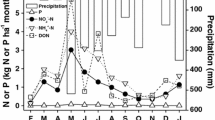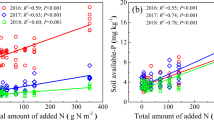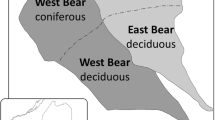Abstract
Increased N inputs through chronic atmospheric deposition has enriched temperate forest ecosystems, altering critical ecosystem functions such as decomposition and potentially resulting in a shift to P limitation. We used a combination of microbial biomass stoichiometry and enzymatic activity analyses to evaluate the potential for microbial nutrient limitation over the course of a growing season in response to multi-decadal, whole-watershed N enrichments and a one time, plot-scale P addition that occurred in the 22nd year of whole-watershed treatments. The one-time P addition increased microbial biomass threefold and reduced N-acetyl-glucosaminidase (NAG) and acid phosphatase (AP) activity 1 week after application, but there was no interaction with long-term experimental N enrichment to indicate a shift to P limitation. However, both N and P treatments increased C limitation independently of each other over the duration of the study based on measured increases in β-1,4-glucosidase (BG) activity relative to NAG and AP. Microbial biomass stoichiometry and enzyme activity indicated that BBWM is P limited regardless of N status. Our findings highlight the complex interactions between C, N, and P use and limitation in a forested ecosystem subjected to long-term N enrichment.



Similar content being viewed by others

References
Aber J, Mcdowell W, Nadelhoffer K, Magill A, Berntson G, Kamakea M, Mcnulty S, Currie W, Rustad L, Fernandez I. 1998. Nitrogen saturation in temperate forest ecosystems: hypotheses revisited. BioScience 48:921–34.
Aber J, Nadelhoffer K, Steudler P, Melillo JM. 1989. Nitrogen saturation in northern forest ecosystems: excess nitrogen from fossil fuel combustion may stress the biosphere. BioScience 39:378–86.
Banfield JF, Barker WW, Welch SA, Taunton A. 1999. Biological impact on mineral dissolution: application of the lichen model to understanding mineral weathering in the rhizosphere. Proceedings of the National Academy of Sciences of the United States of America 96:3404–11.
Bardgett RD, Freeman C, Ostle NJ. 2008. Microbial contributions to climate change through carbon cycle feedbacks. Isme J 2:805–14.
Berg B, Matzner E. 1997. Effect of N deposition on decomposition of plant litter and soil organic matter in forest systems. Environmental Reviews 5:1–25.
Bradford MA, Fierer N, Reynolds JF. 2008. Soil carbon stocks in experimental mesocosms are dependent on the rate of labile carbon, nitrogen and phosphorus inputs to soils. Functional Ecology 22:964–74.
Brookes PC, Landman A, Pruden G, Jenkinson DS. 1985. Chloroform fumigation and the release of soil nitrogen: A rapid direct extraction method to measure microbial biomass nitrogen in soil. Soil Biology and Biochemistry 17:837–42.
Brookes PC, Powlson DS, Jenkinson DS. 1982. Measurement of microbial biomass phosphorus in soil. Soil Biology and Biochemistry 14:319–29.
Carreiro MM, Sinsabaugh RL, Repert DA, Parkhurst DF. 2000. Microbial enzyme shifts explain litter decay responses to simulated nitrogen deposition. Ecology 81:2359–65.
Cleveland CC, Liptzin D. 2007. C:N: P stoichiometry in soil: is there a “Redfield ratio” for the microbial biomass? Biogeochemistry 85:235–52.
Cleveland CC, Reed SC, Townsend AR. 2006. Nutrient regulation of organic matter decomposition in a tropical rain forest. Ecology 87:492–503.
Cleveland C, Townsend A, Schmidt S. 2003. Phosphorus limitation of microbial processes in moist tropical forests: Evidence from short-term laboratory inclubations and field studies. Ecosystems 5:680–91.
Coleman DC. 1994. The microbial loop concept as used in terrestrial soil ecology studies. Microbial Ecology 28:245–50.
Crowley KF, McNeil BE, Lovett GM, Canham CD, Driscoll CT, Rustad LE, Ollinger E, Pardo LH, Schaberg PG, Stoddard JL, Weand MP, Weathers KC. 2012. Do nutrient limitation patterns shift from nitrogen toward phosphorus with increasing nitrogen deposition across the northeastern United States? Ecosystems 15:940–57.
Dijkstra FA, Carrillo Y, Pendall E, Morgan JA. 2013. Rhizosphere priming: A nutrient perspective. Frontiers in Microbiology 4:1–8.
Driscoll CT, Lawrence GB, Bulger AJ, Thomas JB, Cronan CS, Eagar CR, Lambert KF, Likens GE, Stoddard JL, Weathers KC. 2001. Acidic deposition in the Northeastern United States: Sources and inputs, ecosystem effects, and management strategies. BioScience 51:180–98.
Eisenlord SD, Freedman Z, Zak DR, Xue K, He Z, Zhou J. 2013. Microbial mechanisms mediating increased soil C storage under elevated atmospheric N deposition. Applied and Environmental Microbiology 79:1191–9.
Elser JJ, Sterner RW, Gorokhova E, Fagan WF, Markow TA, Cotner JB, Harrison JF, Hobbie SE, Odell GM, Weider LW. 2000. Biological stoichiometry from genes to ecosystems. Ecology Letters 3:540–50.
Elvir JA, Rustad L, Wiersma GB, Fernandez I, White AS, White GJ. 2005. Eleven-year response of foliar chemistry to chronic nitrogen and sulfur additions at the Bear Brook Watershed in Maine. Canadian Journal of Forest Research 35:1402–10.
Falkowski PG, Fenchel T, Delong EF. 2008. The microbial engines that drive earth’s biogeochemical cycles. Science 320:1034–9.
Fatemi FR, Fernandez IJ, Simon KS, Dail DB. 2016. Nitrogen and phosphorus limitations to soil enzyme activities in acid forest soils. Soil Biology and Biochemistry 98:171–9.
Fatemi FR, Fernandez IJ, Szillery J, Norton SA, Rustad LE. 2012. Soil solution chemical response to two decades of experimental acidification at the Bear Brook Watershed in Maine. Water, Air, & Soil Pollution 223:6171–86.
Fernandez IJ, Adams MB, SanClements MD, Norton SA. 2010. Comparing decadal responses of whole-watershed manipulations at the Bear Brook and Fernow experiments. Environmental Monitoring and Assessment 171:149–61.
Fernandez IJ, Karem JE, Norton SA, Rustad LE. 2007. Temperature, soil moisture, and streamflow at the Bear Brook Watershed in Maine (BBWM). Maine Agricultural and Forest Expeirment Station Technical Bulletin 196.
Fisk MC, Ratliff TJ, Goswami S, Yanai RD. 2014. Synergistic soil response to nitrogen plus phosphorus fertilization in hardwood forests. Biogeochemistry 118:195–204.
Fog K. 1988. The effect of added nitrogen on the rate of decomposition of organic matter. Biological Reviews 63:433–62.
Frey SD, Knorr M, Parrent JL, Simpson RT. 2004. Chronic nitrogen enrichment affects the structure and function of the soil microbial community in temperate hardwood and pine forests. Forest Ecology and Management 196:159–71.
Frey SD, Ollinger S, Nadelhoffer K, Bowden R, Brzostek E, Burton A, Caldwell BA, Crow S, Goodale CL, Grandy AS, Finzi A, Kramer MG, Lajtha K, LeMoine J, Martin M, McDowell WH, Minocha R, Sadowsky JJ, Templer PH, Wickings K. 2014. Chronic nitrogen additions suppress decomposition and sequester soil carbon in temperate forests. Biogeochemistry 121:305–16.
Gallardo A, Schlesinger WH. 1994. Factors limiting microbial biomass in the mineral soil and forest floor of a warm-temperate forest. Soil Biology and Biochemistry 26:1409–15.
Galloway JN, Townsend AR, Erisman JW, Bekunda M, Cai Z, Freney JR, Martinelli LA, Seitzinger SP, Sutton MA. 2008. Transformation of the nitrogen cycle: recent trends, questions, and potential solutions. Science 320:889–92.
Geisseler D, Horwath WR, Joergensen RG, Ludwig B. 2010. Pathways of nitrogen utilization by soil microorganisms: A review. Soil Biology and Biochemistry 42:2058–67.
Groffman PM, Fisk MC. 2011. Phosphate additions have no effect on microbial biomass and activity in a northern hardwood forest. Soil Biology and Biochemistry 43:2441–9.
Hartman WH, Richardson CJ. 2013. Differential nutrient limitation of soil microbial biomass and metabolic quotients (qCO2): Is there a biological stoichiometry of soil microbes? PloS One 8:1–14.
Hinsinger P. 2001. Bioavailability of soil inorganic P in the rhizosphere as affected by root-induced chemical changes: a review. Plant and Soil 237:173–95.
Hobbie S, Vitousek P. 2000. Nutrient limitation of decomposition in Hawaiian forests. Ecology 81:1867–77.
Holmes WE, Zak DR, Pregitzer KS, King JS. 2003. Soil nitrogen transformations under Populus tremuloides, Betula papyrifera and Acer saccharum following 3 years exposure to elevated CO2 and O3. Global Change Biology 9:1743–50.
Janssens IA, Dieleman W, Luyssaert S, Subke J-A, Reichstein M, Ceulemans R, Ciais P, Dolman AJ, Grace J, Matteucci G, Papale D, Piao SL, Schulze E-D, Tang J, Law BE. 2010. Reduction of forest soil respiration in response to nitrogen deposition. Nature Geoscience 3:315–22.
Joergensen RG, Wu J, Brookes PC. 2011. Measuring soil microbial biomass using an automated procedure. Soil Biology and Biochemistry 43:873–6.
Kouno K, Tuchiya Y, Ando T. 1995. Measurement of soil microbial biomass phosphorus by an anion exchange membrane method. Soil Biology and Biochemistry 27:1353–7.
Leff JW, Jones SE, Prober SM, Barberán A, Borer ET, Firn JL, Harpole WS, Hobbie SE, Hofmockel KS, Knops JMH, McCulley RL, La Pierre K, Risch AC, Seabloom EW, Schütz M, Steenbock C, Stevens CJ, Fierer N. 2015. Consistent responses of soil microbial communities to elevated nutrient inputs in grasslands across the globe. Proceedings of the National Academy of Sciences 112:10967–72.
Lehmann J, Kleber M. 2015. The contentious nature of soil organic matter. Nature 528:60–8.
Lovett GM, Arthur MA, Weathers KC, Fitzhugh RD, Templer PH. 2013. Nitrogen addition increases carbon storage in soils, but not in trees, in an eastern US deciduous forest. Ecosystems 16:980–1001.
Lynch JP, Ho MD. 2005. Rhizoeconomics: Carbon costs of phosphorus acquisition. Plant and Soil 269:45–56.
Manzoni S, Taylor P, Richter A, Porporato A, Ågren GI. 2012. Environmental and stoichiometric controls on microbial carbon-use efficiency in soils. New Phytologist 196:79–91.
Marklein AR, Houlton BZ. 2012. Nitrogen inputs accelerate phosphorus cycling rates across a wide variety of terrestrial ecosystems. New Phytologist 193:696–704.
McGill WB, Cannon KR, Robertson JA, Cook FD. 1986. Dynamics of soil microbial biomass and water-soluble organic C in Breton L after 50 years of cropping to two rotations. Canadian Jouranl of Soil Science 66:1–19.
McGroddy M, Silver W, Cosme de Oliveira R Jr. 2004. The effect of phosphorus availability on decomposition dynamics in a seasonal lowland Amazonian forest. Ecosystems 7:172–9.
Mineau MM, Fatemi FR, Fernandez IJ, Simon KS. 2014. Microbial enzyme activity at the watershed scale: response to chronic nitrogen deposition and acute phosphorus enrichment. Biogeochemistry 117:131–42.
Minick KJ, Fisk MC, Groffman PM. 2011. Calcium and phosphorus interact to reduce mid-growing season net nitrogen mineralization potential in organic horizons in a northern hardwood forest. Soil Biology and Biochemistry 43:271–9.
Moorhead DL, Rinkes ZL, Sinsabaugh RL, Weintraub MN. 2013. Dynamic relationships between microbial biomass, respiration, inorganic nutrients and enzyme activities: Informing enzyme-based decomposition models. Frontiers in Microbiology 4:1–12.
Mooshammer M, Wanek W, Zechmeister-Boltenstern S, Richter A. 2014. Stoichiometric imbalances between terrestrial decomposer communities and their resources: Mechanisms and implications of microbial adaptations to their resources. Frontiers in Microbiology 5:1–10.
Naples BK, Fisk MC. 2010. Belowground insights into nutrient limitation in northern hardwood forests. Biogeochemistry 97:109–21.
Nave LE, Vance ED, Swanston CW, Curtis PS. 2009. Impacts of elevated N inputs on north temperate forest soil C storage, C/N, and net N-mineralization. Geoderma 153:231–40.
Norton S, Fernandez IJ, Amirbahman A, Coolidge K, Navrátil T. 2006. Aluminum, phosphorus, and oligotrophy–Assuembling the pieces of the puzzle. Verhandlungen der Internationalen Vereinigung für Theoretische und Angewandte Limnologie 29:1877–86.
Olander LP, Vitousek PM. 2000. Regulation of soil phosphatase and chitinase activity by N and P availability. Biogeochemistry 49:175–90.
Peñuelas J, Poulter B, Sardans J, Ciais P, van der Velde M, Bopp L, Boucher O, Godderis Y, Hinsinger P, Llusia J, Nardin E, Vicca S, Obersteiner M, Janssens IA. 2013. Human-induced nitrogen-phosphorus imbalances alter natural and managed ecosystems across the globe. Nature communications 4:2934.
Pinheiro J, Bates D, DebRoy S, Sarkar D, R. C. Team. 2015. nlme: Linear and Nonlinear Mixed Effects Models. R Foundation for Statistical Computing.
Porder S, Vitousek PM, Chadwick OA, Chamberlain CP, Hilley GE. 2007. Uplift, erosion, and phosphorus limitation in terrestrial ecosystems. Ecosystems 10:158–70.
Pregitzer KS, Burton AJ, Zak DR, Talhelm AF. 2008. Simulated chronic nitrogen deposition increases carbon storage in Northern Temperate forests. Global Change Biology 14:142–53.
R Core Team. 2015. R: A language and environment for statistical computing. Vienna: R Foundation for Statistical Computing.
RStudio Team. 2015. RStudio: Integrated Development for R. Boston, MA: RStudio Inc.
Salvino CJ. 2014. Is nitrogen cycling and bioavailability limited by phosphorus in northern New England forest soils?. Orono: University of Maine.
SanClements MD, Fernandez IJ, Norton SA. 2010. Phosphorus in soils of temperate forests: Linkages to acidity and aluminum. Soil Science Society of America Journal 74:2175.
Schimel JP, Weintraub MN. 2003. The implications of exoenzyme activity on microbial carbon and nitrogen limitation in soil: a theoretical model. Soil Biology and Biochemistry 35:549–63.
Schlesinger WH, Bernhardt ES. 2013. The global cycles of nitrogen and phosphorus Biogeochemistry an analysis of global change. 3rd edn. Waltham (MA): Academic Press, Inc. pp 445–67.
Schmidt SK, Costello EK, Nemergut DR, Cleveland CC, Reed SC, Weintraub MN, Meyer AF, Martin AM. 2007. Biogeochemical consequences of rapid microbial turnover. Ecology 88:1379–85.
See CR, Yanai RD, Fisk MC, Vadeboncoeur MA, Quintero BA, Fahey TJ. 2015. Soil nitrogen affects phosphorus recycling: foliar resorption and plant-soil feedbacks in a northern hardwood forest. Ecology 96:2488–98.
Simon KS, Chadwick MA, Huryn AD, Valett HM. 2010. Stream ecosystem response to chronic deposition of N and acid at the Bear Brook Watershed, Maine. Environmental Monitoring and Assessment 171:83–92.
Sinsabaugh RL, Gallo ME, Lauber C, Waldrop MP, Zak DR. 2005. Extracellular enzyme activities and soil organic matter dynamics for northern hardwood forests receiving simulated nitrogen deposition. Biogeochemistry 75:201–15.
Sinsabaugh RL, Hill BH, Follstad Shah JJ. 2009. Ecoenzymatic stoichiometry of microbial organic nutrient acquisition in soil and sediment. Nature 462:795–8.
Sinsabaugh RL, Lauber CL, Weintraub MN, Ahmed B, Allison SD, Crenshaw C, Contosta AR, Cusack D, Frey S, Gallo ME, Gartner TB, Hobbie SE, Holland K, Keeler BL, Powers JS, Stursova M, Takacs-Vesbach C, Waldrop MP, Wallenstein MD, Zak DR, Zeglin LH. 2008. Stoichiometry of soil enzyme activity at global scale. Ecology Letters 11:1252–64.
Sinsabaugh RL, Liptak M. 1997. Enzymatic conversion of plant biomass. In: Soderstrom B, Wicklow DT, Eds. The Mycota: Environmental and Microbial Relationships. Berlin, Germany: Springer. p 347–57.
Stevenson BA, Sarmah AK, Smernik R, Hunter DWF, Fraser S. 2016. Soil carbon characterization and nutrient ratios across land uses on two contrasting soils: Their relationships to microbial biomass and function. Soil Biology and Biochemistry 97:50–62.
Talbot JM, Treseder KK. 2012. Interactions among lignin, cellulose, and nitrogen drive litter chemistry-decay relationships. Ecology 93:345–54.
Tatariw C. 2016. The impact of anthropogenic disturbance on soil microbial community composition and activity: Implications for ecosystem function. Orono: University of Maine.
Treseder KK. 2008. Nitrogen additions and microbial biomass: A meta-analysis of ecosystem studies. Ecology Letters 11:1111–20.
Vitousek PM, Porder S, Houlton BZ, Chadwick OA. 2010. Terrestrial phosphorus limitation: mechanisms, implications, and nitrogen: phosphorus interactions. Ecological Applications 20:5–15.
de Vries W, Du E, Butterbach-Bahl K. 2014. Short and long-term impacts of nitrogen deposition on carbon sequestration by forest ecosystems. Current Opinion in Environmental Sustainability 9:90–104.
Waldrop MP, Zak DR, Sinsabaugh RL, Gallo M, Lauber C. 2004. Nitrogen deposition modifies soil carbon storage through changes in microbial enzymatic activity. Ecological Applications 14:1172–7.
Wallenstein MD, McNulty S, Fernandez IJ, Boggs J, Schlesinger WH. 2006. Nitrogen fertilization decreases forest soil fungal and bacterial biomass in three long-term experiments. Forest Ecology and Management 222:459–68.
Xu X, Thornton PE, Post WM. 2013. A global analysis of soil microbial biomass carbon, nitrogen and phosphorus in terrestrial ecosystems. Global Ecology and Biogeography 22:737–49.
Yanai RD. 1992. Phosphorus Budget of a 70-Year-Old Northern Hardwood Forest. Biogeochemistry 17:1–22.
Acknowledgements
We thank Cheryl Spencer for her invaluable assistance coordinating soil collection and processing. Derek Rothenheber, Tyler Coleman, and Nick Lawson were instrumental in acquiring biomass and enzyme assay data. Drs. Farrah Fatemi, Madeliene Mineau, and Thomas Parr provided guidance for optimizing the enzyme protocol. This research was funded by NSF DEB-1119709 and DEB-1056692 awarded to I.J.F., J.D.M, and K.S. Additional laboratory analyses were provided by the University of Maine Analytical Laboratory and Maine Soil Testing Service. We thank the 2 anonymous reviewers for their constructive and insightful feedback. This project was supported by the USDA National Institute of Food and Agriculture, Hatch project #ME0-41507. This is a Maine Agricultural and Forest Experiment Station Publication.
Author information
Authors and Affiliations
Corresponding author
Electronic supplementary material
Below is the link to the electronic supplementary material.
Rights and permissions
About this article
Cite this article
Tatariw, C., MacRae, J.D., Fernandez, I.J. et al. Chronic Nitrogen Enrichment at the Watershed Scale Does Not Enhance Microbial Phosphorus Limitation. Ecosystems 21, 178–189 (2018). https://doi.org/10.1007/s10021-017-0140-1
Received:
Accepted:
Published:
Issue Date:
DOI: https://doi.org/10.1007/s10021-017-0140-1



